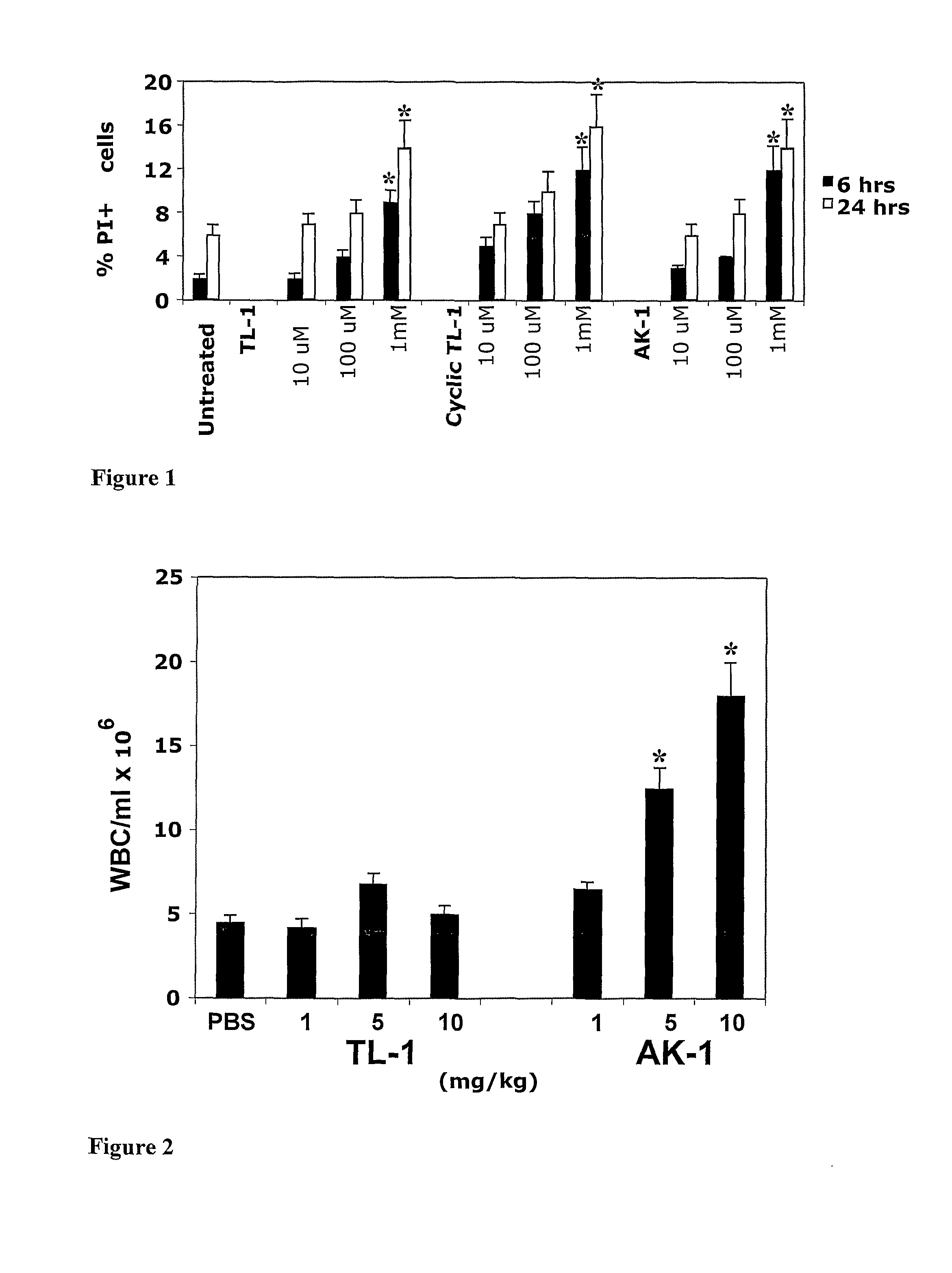Short beta-defensin-derived peptides
a beta-defensin and peptide technology, applied in the field of defensin-derived peptides, can solve the problems that the cyclization effect and the resulting activity of the peptide cannot be predicted, and achieve the effect of improving the accessibility of the peptide to cancer
- Summary
- Abstract
- Description
- Claims
- Application Information
AI Technical Summary
Benefits of technology
Problems solved by technology
Method used
Image
Examples
example 1
Effect of the Peptides on Cell Viability
[0209]In order to test cytotoxicity of the peptides, human pre-B-ALL G2 cells and freshly isolated primary human CD3+ T cells (1×106 / ml) were cultured in with 10 μM, 100 μM or 1 mM of TL-1, AK-1 and cyclic TL-1, as described in the Material and Methods. All tested peptides were not toxic for G2 cells (FIG. 1) as well as for primary human T cells at 10 μM and 100 μM. Even in the highest concentration, 1 mM, the peptides killed only 8-12% and 14-16% cells treated for 6 and 24 hrs, respectively, indicating a very low cytotoxicity of the peptides.
example 2
Effect of the Peptides on White Blood Cell (WBC) Mobilization
[0210]The cell mobilizing potential of the peptides was examined in intact C57BL / 6 mice, using the protocol applied for AMD3100 (Broxmeyer, H. E., et al., 2005). First, the effect of different doses of the peptides was evaluated. Mice were s.c. injected with 1, 5 and 10 mg / kg of TL-1 (linear and cyclic) or AK-1, sacrificed 1-2 hr later and the total number of WBC in 1 ml of blood was determined (see Materials and Methods). It was found that linear TL-1 was ineffective at a dose of 1 mg / kg, but at doses of 5 and 10 mg / kg it induced WBC mobilization. AK-1 induced WBC mobilization in a clear dose-dependent manner (FIG. 2). In all tested doses, cyclic TL-1 did not induce WBC mobilization.
[0211]Next, the mobilizing activity of the peptides in comparison with AMD3100 was examined, as well as their mobilizing activity in combination with AMD3100 or G-SCF. In these experiments, the peptides and AMD3100 were s.c. injected at a dose...
example 3
Effect of the Peptides on Progenitor Cell Mobilization
[0213]In the same experiments, blood mononuclear cells were collected and tested for the presence of colony-forming cells reflecting the number of HPC. In the dose response experiments, linear TL-1 significantly induced mobilization of HPC, equally at all doses used, namely 1, 5 and 10 mg / kg. AK-1, at 1 mg / kg, induced HPC mobilization reaching the strongest effect at 5 and 10 mg / kg (FIG. 3). Cyclic TL-1 did not induce mobilization of HPC at doses of 1 and 5 mg / kg. At a dose of 10 mg / kg it revealed an inhibitory effect. As found for WBC mobilization, the capability of AK-1 to induce HPC mobilization in the mouse model was higher than that of TL-1. In addition, in an equal dose (5 mg / kg) the HPC mobilization capability of AK-1 was even stronger than that of AMD3100 (FIG. 5). In combination with AMD3100 or G-CSF, TL-1 revealed an additive effect. Cyclic TL-1 induced an inhibitory effect, and it also inhibited AMD3100-induced mobiliz...
PUM
| Property | Measurement | Unit |
|---|---|---|
| Fraction | aaaaa | aaaaa |
Abstract
Description
Claims
Application Information
 Login to View More
Login to View More - R&D
- Intellectual Property
- Life Sciences
- Materials
- Tech Scout
- Unparalleled Data Quality
- Higher Quality Content
- 60% Fewer Hallucinations
Browse by: Latest US Patents, China's latest patents, Technical Efficacy Thesaurus, Application Domain, Technology Topic, Popular Technical Reports.
© 2025 PatSnap. All rights reserved.Legal|Privacy policy|Modern Slavery Act Transparency Statement|Sitemap|About US| Contact US: help@patsnap.com



